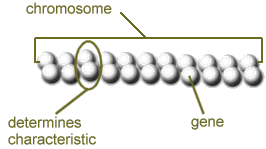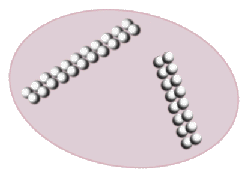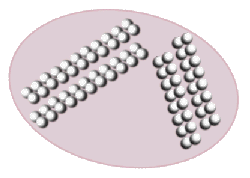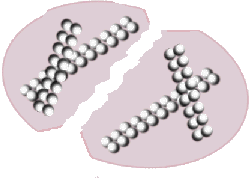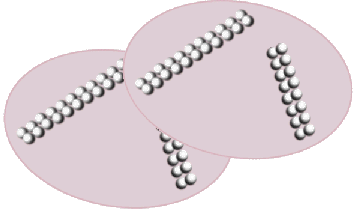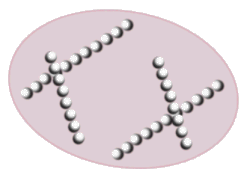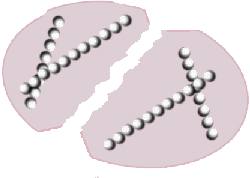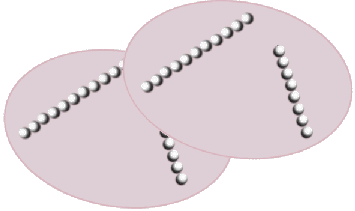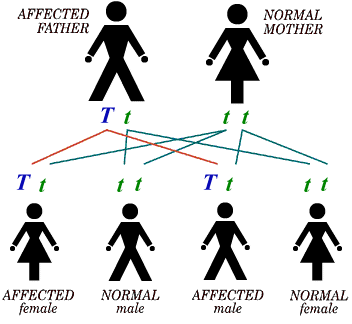
![]()
|
TCS is Autosomal Dominant. What is it all about?! Yes we've all been told it means that males and females are equally affected, and the chances of passing the syndrome on are 50% and if it is passed on the individual will be affected. But do you understand why? Could you explain it to someone else? Genetics is an extremely complex and involved subject, but I aim to explain to you what you need to know, how it all works and why the chances of passing TCS on to children is 50%. I will explain this in a reasonably technical way, but please be patient ... I have also provided a nice clear, simplified explanation in italics with illustration. Please read the sections in the order presented. You can do this by simply scrolling down the page. Should you wish to recap any sections you can use the index of links below to go directly to your chosen section |
 |

|
|
The genetic information that determines all our characteristics is carried in genes. Each gene is responsible for a different characteristic such as hair colour, eye colour etc. Each cell in our body contains many chromosomes; each chromosome contains many genes. These chromosomes are present in pairs. There are 2 chromosomes responsible for determining the gender of the individual, and there are 22 pairs of chromosomes responsible for our other characteristics. So there are 46 chromosomes in a cell. Diagram |
|
Genes are sections of DNA (DeoxyriboNucleic Acid) threads. These DNA threads make up chromosomes. Chromosomes are present in pairs (known as homologous pairs), both members have the same length (and number of genes). One chromosome comes from the father and one chromosome from the mother. (this will be explained further in a later section. In order to visualise this concept imagine an unfastened beaded necklace. The beads are the genes, the whole necklace formed by the beads (genes) is a chromosome. Add another similar necklace to make up the pair (homologous pair) FIG 1 2 genes (beads) at an identical position on a pair of homologous chromosomes (necklaces) together determine a particular characteristic.
|
|
There are two types of cell division: Mitosis and Meiosis. Generally speaking the cell division concerned with genetics is Meiosis and this will take place in the sex organs. Mitosis takes place in other areas and is concerned with growth, replacement of dead cells and repair of tissues. You do not need to know about Mitosis, I have added it for completion. If you wish you can skip straight to meiosis. More detailed explanations of both types of cell division now follow: |
|
Meiosis produces new cells which are used for reproduction. This is the cell production we are interested in. There is no replication of the chromosomes first. The pairs of chromosomes are separated (Fig 7) and divided between the two daughter cells (Fig 8). (ie, one string of beads from each pair of necklaces goes to each new cell). The pairs of chromosomes in the original diploid cell are separated to form two cells known as HAPLOID GAMETES (Fig 9) - they have half the usual number of chromosomes, (or the necklaces are present as single strings of beads, not pairs) Therefore in Meiosis a diploid cell becomes two haploid cells, each containing half of the information from the original (Fig 9).
[TIP: Think of Mitosis as taking a photocopy of a cell - you double it to provide 2 exact copies. Think of Meiosis as cutting the original up to provide two halves of an original.] | ||||||||
 |
|
If a dominant gene is present, the characteristic it is responsible for will be expressed. Recessive genes will only express themselves if their partner (adjacent bead on the other necklace) is also a recessive gene. (Fig 10) Imagine the beaded necklaces are made up of black and white beads. Black is a dominant gene and white is recessive. If on one necklace the 3rd bead is black and on the other necklace it is white, the black gene would determine the characteristic. The same characteristic would also occur if both beads were black. The white characteristic would only be expressed if both beads were white.
| ||||||||||
|
A well known genetic characteristic is the tongue roller. The gene which determines that a person can roll their tongue is dominant. If the person possesses the dominant gene at the relevant position on either of the relevant chromosomes (necklaces) they will be able to roll their tongue. If a person cannot roll their tongue they posses two recessive genes for this characteristic. If neither of your parents can roll their tongue, then you will not be able to either. Neither would have possessed the dominant gene to pass on to you. The notation often used to describe the combination of genes denoting a characteristic is a capital letter for the dominant gene and a lower case letter for the recessive. For example, for tongue rolling the letter R or r could be used which would provide the following possible combinations:
| ||||||||||||
 |
|
A mutation is a change in the DNA of an organism. It may affect a single gene (such as TCS) or a whole chromosome (such as Down's Syndrome). Mutations occur randomly, that is, any gene can undergo mutation at any time. It is possible for an accident to happen during meiosis where an extra chromosome reaches the gamete. This is an example of a mutation which affects a whole chromosome. Older mothers have a higher chance of producing Mongol (Down's syndrome) babies by this means. Mongols have 47 chromosomes instead of the usual 46. When a mutation occurs, the nature of the DNA, or its quantity alters and the information carried by the gene is "broken". As the alteration in the gene can vary it will be slightly different for each family. Once this broken gene is present it becomes hereditary. There is nothing that can be done to prevent TCS occurring in this way; it is certainly not caused by any actions of the parents. Parents who do have a child with TCS by genetic mutation are very unlikely to have another child with it. The gene has now been located on chromosome #5 and has been named "Treacle". You can read articles about the discovery of the chromosome in 1991 and the gene in 1996:
| ||||
 |
|
Now we know how the genes contained in chromosomes work and determine our characteristics. We also know how the cells containing the chromosomes divide their information into new sex cells (Haploid Gametes by Meiosis). We can put it all together and see where TCS fits in. There are two ways a person can have TCS: by inheriting the dominant gene from a parent who has TCS (and we know that if you do inherit a dominant gene you will have that characteristic. Alternatively, a person may be an isolated (sporadic) case, as explained in mutation There is a 50% chance that a person with TCS will pass the dominant gene on to a child. Using what you know about dominant genes and the cell division which takes place when sex cells are produced (meiosis) you will understand why this is so. Remember earlier we said that of all our pairs of chromosomes one chromosome comes from the mother and one from the father? This is because the cells passed on when we are conceived are the haploid gametes which contain half the number of chromosomes.
Using the notation we introduced in our earlier example we can see the possible combinations that may occur in a child who has one parent with TCS. T represents the dominant gene. This is the gene which causes TCS Parent 1 has TCS, Parent 2 does not
Table 1 shows the Cells that can be passed on by the parent. Remember the child will obtain one from parent 1 and one from parent 2. Table 2 shows the outcomes of the possible combinations
As you can see 1/2 of the resulting new gene pairs contain the dominant T gene therefore there is a 50% chance the child will have one of these combinations and therefore have TCS. A similar table can be used to see what would happen if both parents had TCS:
Three out of four of the possible combinations contain the dominant T gene so there is 75% chance of the child having TCS. One of the gene combinations has a double T gene. A person with this double T gene would definitely pass a dominant T gene on to its children, therefore any offspring would have TCS. If only the TCS gene was recessive! | ||||||||||||||||||||||||||||||||||
 | ||||||||||||||||||||||||||||||||||
|
